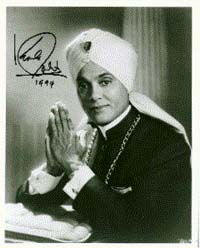Home · Listener's Guide · The Songs · Who's Who · Liner Notes · Selected Tracks · What's New · Search

Korla Pandit
- Born John Roland Redd, 16 September 1921, Columbia, Missouri
- Died 1 October 1998, Santa Rosa, California
 One of the icons of exotica, Pandit embodies the complexities of the genre in more than one way. Pandit came to fame in the early 1950s, when he appeared on a 15-minute show, "Adventures in Music," on television station KTLA in Los Angeles. While he played some piece of exotica like "Jalousie" on the Wurlitzer, his face, topped by a white turban and and oval jewel--looking like Orphan Annie's Indian helper--filled the screen, surrounded by a gauzy haze. His soulful gaze is said to have drawn housewives into rapturous fantasies.
One of the icons of exotica, Pandit embodies the complexities of the genre in more than one way. Pandit came to fame in the early 1950s, when he appeared on a 15-minute show, "Adventures in Music," on television station KTLA in Los Angeles. While he played some piece of exotica like "Jalousie" on the Wurlitzer, his face, topped by a white turban and and oval jewel--looking like Orphan Annie's Indian helper--filled the screen, surrounded by a gauzy haze. His soulful gaze is said to have drawn housewives into rapturous fantasies.
According the story Pandit told for most of his career, his father sent him to England and later the United States to be educated, and he eventually ended up as a student at the University of Chicago. He claimed to have taught himself the electric organ, then just beginning to become available commercially, in three days to qualify for a job as organist with a Chicago radio station, and went on to hold jobs with other local stations.
As R.J. Smith revealed in his article, "The Many Faces of Korla Pandit," in the July 2001 edition of Los Angeles Magazine, however, this, along with much of Pandit's facade, was a fiction. His birthplace was Columbia, Missouri, and he was an African-American, not an Indian, despite what his death certificate would ultimately say. Pandit was born to Ernest Redd, pastor of the Second Baptist Church, the largest black church in Columbia, and Doshia O'Nina Redd, who was of Creole lineage. One of seven children, John Roland (as he was known when he was growing up) early on displayed a natural talent for the piano. The jazz organist, Sir Charles Thompson, lived in Columbia at the same time and recalled that John Roland was considered the best piano player in town. His older brother, Ernest Redd, Jr. went on to lead one of the dance bands, known as "territory bands," that played the black circuit in Missouri, Kansas, and Nebraska.
Somewhere around 1940, John Roland joined the large migration of blacks and whites from the Midwest to southern California. He found work as a pianist, and might have become well-known under his own name as a jazz or R&B musician had it not been for his decision to bill himself as "Juan Rolando" at one appearance. Playing Latin tunes, which were quite the rage, "Juan" found it easier to line up subsequent gigs than John Roland had, and passing as a Mexican, he was able to join the whites-only local of the Musicians Union. His reputation grew, and he moved from clubs to theatre appearances, and even landed a job playing on the "Chandhu the Magician" radio show. He also met and began living with a white woman, Beryl DeBeeson, who worked as an animator at Disney.
The "Zoot Suit" riots of 1945 climaxed a growing conflict between the white and Mexican populations in Los Angeles, and may have had something to do with John Roland Redd's decision to mutate again, from "Juan Rolando," Mexican, to "Korla Pandit," Indian. In any case, by 1949, he could be heard on "Hollywood Holiday," a radio show broadcast from a local restaurant. He and Beryl had also married after California's law against mixed marriages was struck down in 1948. Along with his new identity when his jewel-topped turban, which Hollywood had already turned into an icon of its own kitschy fiction of Oriental culture--despite the fact, as Smith points out, that Sikhs, not Hindus, were turbans, and even then without any ornamentation.
Around that time, Pandit appeared at the opening of a pet store that was broadcast by local television station KTLA. Klaus Landsberg, the station's founder and owner, Back in the days when shows could be as brief as 10-minute spots, content was in demand, and Landsberg figured Pandit's novelty could hold his tiny but growing audience of viewers. He also required Pandit to provide the music for a puppet show, "Time for Beany," as part of the deal.
The show, "Adventures in Music with Korla Pandit," was unlike anything seen before (not that that couldn't be said of many shows at the time). A bright, luminous light filled the screen, eventually fading to a shot of Pandit's hands on the keyboard as he played his original theme, "Magnetic Theme." Pandit never spoke. Instead, viewers watched alternating shots of Pandit's face, Pandit at the organ, and Pandit's hands, with occasional shots of a company of exotic dancers. At times he played both organ and piano simultaneously, one hand on each keyboard. Much of the time, the camera stayed on Pandit's face as he gazed soulfully into it. As Smith puts it,
Born at a time when a black man in the South could get whipped for making eye contact with a white woman, Koala Pandit was making dreamy eyes at thousands upon thousands of aproned homemakers, stealing into their dens as they heated their fondue pots.Landsberg's hunch paid off wildly, as Pandit quickly became one of the early celebrities of television. He and Beryl bought a house in the Hollywood Hills, and he could be seen partying with the likes of Errol Flynn.
His father, Ernest Redd, moved to Los Angeles in the early 1950s and began preaching for a congretation in the black area around Central Avenue. Pandit would visit his father on occasion, but he stayed in his new character all the time and refused to bring his two sons, Shari or Koram, to see their grandfather. He had also adopted an English accent and a strange manner of speaking that always stayed at vague, apparently spiritual level. His nephew Ernest recalled that, "It got to a point he didn't even speak very good English because he had talked that Hinduism or whatchacallit for so long."
Pandit left KTLA in 1951, lured by a lucrative deal for a new television show, produced by Louis Snader, a Los Angeles real estate developer. Snader began taping shows and franchising them around the country, and Pandit's national fame began to grow. But when the initial contract ended, negotiations got hung up over issues like rights to fan mail, about which Pandit, sensitive to disclosure of his facade, was particularly sensitive. Eventually, San Francisco station KGO picked him up, and Snader ended up giving the show to a young pianist with a facade of his own, known as Liberace. Despite this, Pandit was so popular among San Francisco viewers that in 1957, a local poll found him the local personality most deserving of national recognition. Bay Area label Fantasy signed him to a contract and he recorded an eye-watering thirteen albums in just three years.
By that time, however, Pandit had began to break his silence on his shows, and to speak about what he called "the Universal Language of Music." This hodge-podge of genuine and ersatz mysticism caught on with a small portion of the audience--that slice of California demographics that fostered its reputation as "the land of fruits and nuts." But most viewers preferred their music philosphy-free, and by 1961 or so, Pandit left the airwaves, at least as far as live performances were concerned. Snader's tapes would go on to circulate among small stations and fill timeslots at odd hours for years.
For most of the next two decades, Pandit focused on theatre appearances. He got distribution rights to his albums, and was selling them at shows long after Fantasy stopped releasing them. Eventually, the house in Hollywood Hills was traded for a tract house in Vancouver, Canada. His venues shrunk along with his audiences. Large theaters were replaced by retirement homes and "Pizza and Pipes" restaurants. Eventually, he left his home with Beryl and became something of a drifter, moving from girlfriend to girlfriend, sometimes in his own place, sometimes crashing on a friend's couch for months. His polished and enigmatic style never changed, though, and eventually he was rediscovered by a new generation of fans with the resurgence of interest in lounge and exotica music.
He appeared in the 1952 film, "Something to Live For," and again, 25 years later, in Richard Pryor's comedy, "Which Way is Up?" Director Tim Burton gave him his last movie role--as himself, of course--in his 1994 movie, "Ed Wood." He died in a retirement home in Santa Rosa, keeping his persona intact until the very end.
You can find out more about Korla Pandit, the persona and performer, at www.korlapandit.com, created by long-time associate Verne Langdon.
Recordings
- The Grand Moghul Suite, Vita VLP-10 (1948) (reissued on India KLP 1001)
- Korla Pandit's Musical Gems, Vita LP-12 (1948)
- Rememb'ring, Vita LP-14 (1948)
- Merry Christmas, Vita LP-16 (1948)
- Universal Language of Music, Vol. 1, India V-6814-400 (1954)
- Music of the Exotic East, Fantasy 3272/8013 (1958)
- Latin Holiday, Fantasy 3284/8027 (1959)
- Korla Pandit at the Pipe Organ, Fantasy 3286/8018 (1960)
- Tropical Magic, Fantasy 3288/8034 (1959)
- Speak to Me of Love, Fantasy 3293/8039 (1960)
- An Evening with Korla Pandit (also released as "Korla Pandit in Concert"), Fantasy 3304/8049 (1960)
- Music of Mystery and Romance, Fantasy 3320/8061 (1960)
- Love Letters, Fantasy 3327/8070 (1960)
- Hypnotique, Fantasy 3329/8075 (1961)
- Music from Hollywood, Fantasy 3334/8086 (1960)
- Music for Meditation, Fantasy 3342/8342 (1961)
- Korla Pandit in Paris, Fantasy 3347/8347 (1961)
- Christmas with Korla Pandit, Fantasy 3350 (1961)
- The Pipes of Pan, India KLP 1002 (1971)
- Universal Language of Music, Vol. 2--Merry Christmas, India SR4S-4437 (1971)
- Universal Language of Music, Vol. 3, India Z4RS-7625 (1973)
- Meditation, India KLP 1003 (1977)
- Fantastique, National Custom Recording 12-574
- Exotica 2000, Sympathy for the Record Industry SFTRI 387 (1996)
- Odyssey, Fantasy CD (1996)
Korla Pandit.-->
S p a c e A g e P o p M u s i c
Home · Listener's Guide · The Songs · Who's Who · Liner Notes · Selected Tracks · What's New · Search
Email: editor@spaceagepop.com